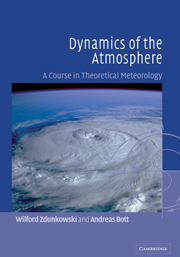Book contents
- Frontmatter
- Contents
- Preface
- Part 1 Mathematical tools
- Part 2 Dynamics of the atmosphere
- 1 The laws of atmospheric motion
- 2 Scale analysis
- 3 The material and the local description of flow
- 4 Atmospheric flow fields
- 5 The Navier–Stokes stress tensor
- 6 The Helmholtz theorem
- 7 Kinematics of two-dimensional flow
- 8 Natural coordinates
- 9 Boundary surfaces and boundary conditions
- 10 Circulation and vorticity theorems
- 11 Turbulent systems
- 12 An excursion into spectral turbulence theory
- 13 The atmospheric boundary layer
- 14 Wave motion in the atmosphere
- 15 The barotropic model
- 16 Rossby waves
- 17 Inertial and dynamic stability
- 18 The equation of motion in general coordinate systems
- 19 The geographical coordinate system
- 20 The stereographic coordinate system
- 21 Orography-following coordinate systems
- 22 The stereographic system with a generalized vertical coordinate
- 23 A quasi-geostrophic baroclinic model
- 24 A two-level prognostic model, baroclinic instability
- 25 An excursion concerning numerical procedures
- 26 Modeling of atmospheric flow by spectral techniques
- 27 Predictability
- Answers to Problems
- List of frequently used symbols
- References and bibliography
- Index
24 - A two-level prognostic model, baroclinic instability
Published online by Cambridge University Press: 05 June 2012
- Frontmatter
- Contents
- Preface
- Part 1 Mathematical tools
- Part 2 Dynamics of the atmosphere
- 1 The laws of atmospheric motion
- 2 Scale analysis
- 3 The material and the local description of flow
- 4 Atmospheric flow fields
- 5 The Navier–Stokes stress tensor
- 6 The Helmholtz theorem
- 7 Kinematics of two-dimensional flow
- 8 Natural coordinates
- 9 Boundary surfaces and boundary conditions
- 10 Circulation and vorticity theorems
- 11 Turbulent systems
- 12 An excursion into spectral turbulence theory
- 13 The atmospheric boundary layer
- 14 Wave motion in the atmosphere
- 15 The barotropic model
- 16 Rossby waves
- 17 Inertial and dynamic stability
- 18 The equation of motion in general coordinate systems
- 19 The geographical coordinate system
- 20 The stereographic coordinate system
- 21 Orography-following coordinate systems
- 22 The stereographic system with a generalized vertical coordinate
- 23 A quasi-geostrophic baroclinic model
- 24 A two-level prognostic model, baroclinic instability
- 25 An excursion concerning numerical procedures
- 26 Modeling of atmospheric flow by spectral techniques
- 27 Predictability
- Answers to Problems
- List of frequently used symbols
- References and bibliography
- Index
Summary
Introduction
In this chapter we are going to discuss the two-level quasi-geostrophic prediction model. This model divides the atmosphere into four layers as shown in Figure 24.1. The vorticity equation is applied to levels l = 1 and l = 3 while the heat equation is applied to level l = 2. By eliminating the vertical velocity ω it becomes possible to determine the tendency of the geopotential ∂φ/∂t. Initially only the geopotential φ(x, y, p, t0 = 0) for the entire vertical pressure range 0 ≤ p ≤ p0 must be available. The discussion will be facilitated by resolving the dependent variables in the vertical direction only. The remaining differentials will be left in their original forms, which may be approximated by finite differences whenever desired.
In the second part of this chapter we are going to discuss the concept of baroclinic instability. In a rotating atmosphere this type of instability, which was first investigated by Charney (1947) and Eady (1949), arises from the vertical wind shear if the static stability is not too large. The stability properties of the Charney model are difficult to analyze. The two-level model, however, makes it possible to obtain the stability criteria in a rather simple way, with results consistent with Charney's model. Details, for example, are given by Haltiner and Williams (1980).
The mathematical development of the two-level model
The basic system consists of the vorticity equation (23.44) and the first law of thermodynamics (23.19).
- Type
- Chapter
- Information
- Dynamics of the AtmosphereA Course in Theoretical Meteorology, pp. 619 - 633Publisher: Cambridge University PressPrint publication year: 2003



